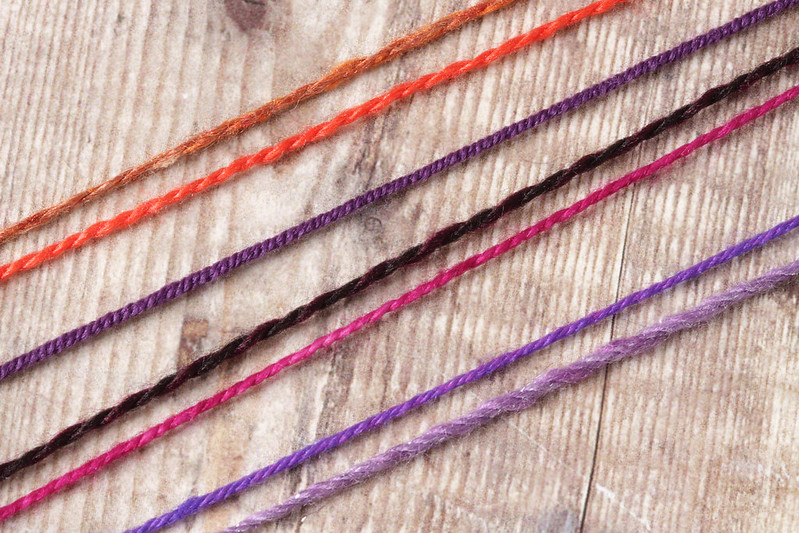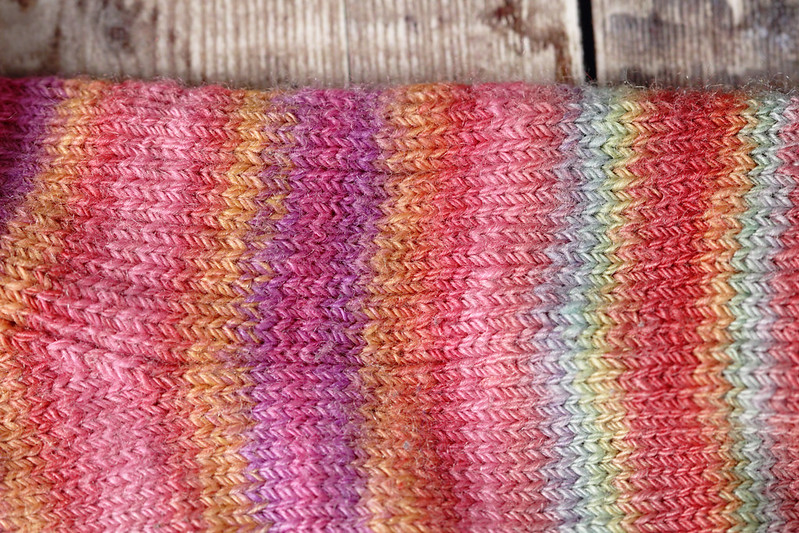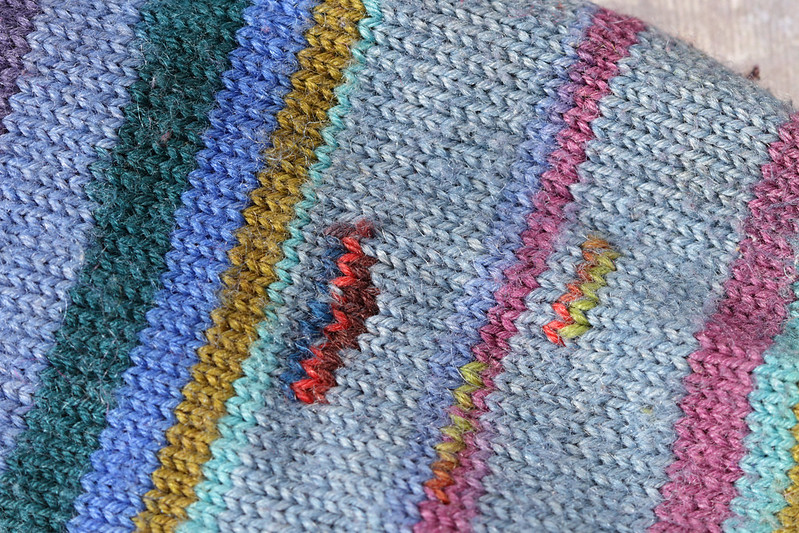I have never cared for rules in creative pursuits, so naturally when I heard “sock yarn need Nylon” I took it with a pinch of salt. Humans have been wearing woollen socks for millennia, and I learned early on in my knitting adventure that I dislike the feel of synthetic blends, so I avoided them instinctively. According to Ravelry, I made my first successful pair of 100% wool socks in 2011 (there were three previous pairs that didn’t fit), and incredibly, they are still going strong despite fortnightly wear. My longest-lasting pair of purchased socks is probably no more than five years old.
Socks are certainly subjected to different types of wear to other garments – from abrasion under stress to more frequent laundering – that test both the tensile strength and abrasion resistance of the fabric. Following on from our previous post We need to talk about Nylon about Nylon’s environmental impact, I wanted to share what I’ve learned about making wool socks that last.
Tension
Many sock patterns are written for 2.5mm needles but I prefer to knit my socks on 2.25mm needles for a nice, tight tension of around 34 stitches to 10cm. If you tend to knit loosely you might want to go to 2mm needles.
Fibre
Not all fleece is equal. Here in the UK we certainly have an appetite for ever-softer Merino, but many knitters don’t realise that comes in different grades that describe the fineness of the fibres. ‘Extra fine’ Merino (also known as ‘super fine’, in the 18 micron range) feels luxuriously soft against the skin and is wonderful for many types of projects, but the fine fibres are not practical for socks. Our Favourite Sock yarn uses thicker Merino in the 21-13 micron range that deliver extra wear while keeping that Merino softness.
Strength comes from the fibre length as well as thickness, and other sheep breeds are especially suited to socks. For example, Bluefaced Leicester wool fleece is around 26 micron, which is still relatively fine and soft, but with a fibre length (or staple) of around 85-90mm (3 1/2″), compared with 75-80mm (3″) of Merino. Wensleydale has glossy fibres similar in appearance to Mohair, with a whopping 200-300mm (8-12″) staple, making it incredibly hard-wearing. At 30-40 micron Wensleydale can feel course, but like Mohair, it is often used in blends with other wools to add strength and shine. We’re starting to see other Nylon-alternatives appearing on the market too, like Onion’s ‘Nettle Sock’ that uses 30% nettle fibres to give extra strength to wool.
Twist
I am a pretty amateur spinner by anyone’s standards, but making my own yarn has taught me so much about how the strength of a yarn comes not just from the fibres used, but the way it is constructed. Many plies are better then fewer plies because if one wears through, the others can take the strain (but if you do see a broken ply you should fix it, see ‘Care’ below). High-twist yarns like our Favourite Sock are much better suited to socks than low twist yarns.

From top: Low-twist woollen-spun 2 ply yarn (rust), low twist Merino 2 ply (orange), low twist multi-ply extra fine ‘baby Merino’ (purple), low twist Nylon blend 2 ply ‘sock yarn’ (black), high twist 2 ply 100% Merino (pink), high-twist 3 ply 100% Bluefaced Leicester (purple), high twist chain plied handspun (lilac)
High-twist yarns have a denser feel that low twist yarns, and the strands sit at a steeper angle. Often when I see commercial sock yarns they are not particularly highly twisted, and I think often Nylon is used to replace that quality of spin that might be more expensive to achieve. If I am spinning for socks, I like to over-spin then chain-ply because I find that this adds a lot of twist, makes a very sturdy, springy 3-ply yarn that’s better suited to the task than anything I can buy.

Sock knitted from handspun, high twist, chain-plied pure merino yarn – still perfect after four years of wear.
Heel
The heel of a sock is a natural wear point so it’s worth making them as strong as possible. A turned heel (also known as a flap heel or gusset heel) is the strongest, having rows of slipped stitches that creates an extra-dense fabric compared to other heal types.
Fit
In my humble experience, the number one killer of socks is them not being made big enough in the first place. When socks are worn they naturally start to stretch in circumference as the foot flexes when we walk. With this width-ways stretch, the socks begin to pull in length-ways, so even if they felt long enough when we we knitted them they become too short. This puts the heel and toe under tension and creating stress points in places that are already getting a lot of abrasion.
It’s nice to have socks that feel snug on the foot, so rather than making them looser, knit them a little longer than you think they should be. Personally, I only make top-down socks these days because I find it’s just too difficult to get the length right toe-up.
I have also found that for a comfortable fit, I need a longer heel flap and toe than is specified in patterns. Everyone’s feet are different, and it’s worth taking some time to experiment to find what fits you, and if they fit you they will last longer.
Wear
I live in a Victorian house with exposed floorboards, may of which are broken and have big nails that pop out, no matter how many times I knock them back in. I wear my socks as slippers. I do this because they are comfortable and because I’m too lazy to put on my actual slippers on all but the coldest days. The inevitable often happens and I accept this.
I do really put my socks through their paces, using them for hiking, and winter running, but I consider this to be expected and acceptable use. Using them as slippers causes far more damage than these activities.
If you want your socks to last, don’t be like me, don’t use your knitted socks as slippers.
Care
Keep a really close eye on your socks and check them before each wear. If you see any holes or areas that have worn then, fix and reinforce them before they get big – the proverbial stitch in time really does save nine! Swiss darning aka ‘duplicate stitch’ (see this simple tutorial and more complex example) is my preferred method for mending as it maintains the elasticity of the fabric and can be done invisibly – although these days I like to use a contrast colour so I can see where I’ve already repaired.
Making repairs comes part and parcel with having knitted socks, regardless of the fibre content. Much of the damage to my socks this winter that wasn’t caused by floor nails, was courtesy of a moth grub that wreaked havoc in my sock draw. Unfazed by Nylon, it ate at least one hole in every single pair. Pure wool socks will no doubt need more mending than Nylon blend socks, but you will be getting out the darning needle at some point regardless.
Mending is slow, and I can’t say I enjoy the process but it is very satisfying once done, and a little row of stitches can extend a sock’s life by months or even years.
If you’re still not sure about ditching the Nylon…
Even if you’re not ready to give up Nylon sock yarn entirely there are lots of ways to reduce the plastic in your hand-knitted wardrobe. What about only using a Nylon blend in a contrast colour for the high-wear heel and toe areas? Or maybe pledging to use Nylon blends only for socks, and natural fibres for low-wear garments like shawls? It all makes a difference!

Brilliant tips, thank you! I’d wondered about needle size but hadn’t thought about the twist of the yarn before. In future my socks will be made in the “right” way!
However, as I – like you – love to wander round in just my socks, I suspect I will have to resign myself to yet more darning for my existing pure wool pairs… Ah well, they’re worth it!
Thanks Alice! Darning is a small price to pay for cosy feet, I feel :)
Thanks for your very well thought out and written information. I really want to knit socks – the ‘need’ for nylon the thing that has held me back – but am now happy to get knitting, thanks to your advice.
Thanks for your lovely message! I’m so happy the post has inspired you to give sock knitting a go. There is nothing quite like hand knitted wool socks!
We live in an old schoolhouse. The nails come up occasionally. Can you try longer nails. I love making socks the old fashioned way. Love your article.
This is so very useful. Sock knitting beginner, I’m delighted to have happened upon this.
love how you mentioned spinning. That’s a topic sooo many people ignore – not only in terms of durability (which is obviously very important for heels and toes) but also in the way it influences the look and feel of the fabric. So many people struggle with their 2×2 ribbings falling apart – and often they are just knitting with the wrong yar.
I am a beginner in knitting socks, and the article has helped me to understand the differences in sock yarn. I now know that I have to be more selective when buying “sock” yarn.
So happy you found this helpful!
I just spun some Suffolk, East Friesian, 50/50 with combed mohair. It turned out just right for heavy winter socks. I’ve been less than impressed with many Superwash wool /nylon blend sock yarn’s durablity. And I am trying to use more natural earth friendly fibers.
Loved this blog post, and happy to read that I am not alone in thinking “beyond nylon”. Your post has inspired me to pay closer attention to the twist qualities of yarn, and to finally learn to make the heel flap. I tend to make socks using the turned-heel short -row method, and as you’ve pointed out, this is often the first part of the sock to wear and which needs mending. Thank you for your post!
Thanks, Maria! I’m glad the post was helpful. The slipped stitches in a flap heel seem to make all the difference. Mine have lasted really well.
Hello. I am totally new to this and hoping to make my father a pair of beautiful, warm, and durable wool socks. Is it possible for you to add a tutorial for sock building? Because I a so new I fear I won’t be able to find a tutorial that complies with all of your recommendations. Thank you!
Hi Desiree,
There’s a bit of trial and error in sock knitting because everyone’s feet are a different shape as well as size. If you’re making them for someone else it is a little tricky because you can’t try them on as you go. Luckily there are many great beginner patterns available that have different size options. Here are a few to look at (all free):
https://www.ravelry.com/patterns/library/late-night-socks
https://www.ravelry.com/patterns/library/exceedingly-vanilla-socks
https://www.ravelry.com/patterns/library/dk-weight-vanilla-socks
The flap heel is one of the more complicated knitting techniques in general, but it does give a far superior fit and last longer, so it’s well worth it. Perfecting the fit for yourself is something that comes with time, you may not know until you wear the socks that they are tight around the ball of the foot or too short in the toe, but once you know you can adjust the pattern for the next pair.